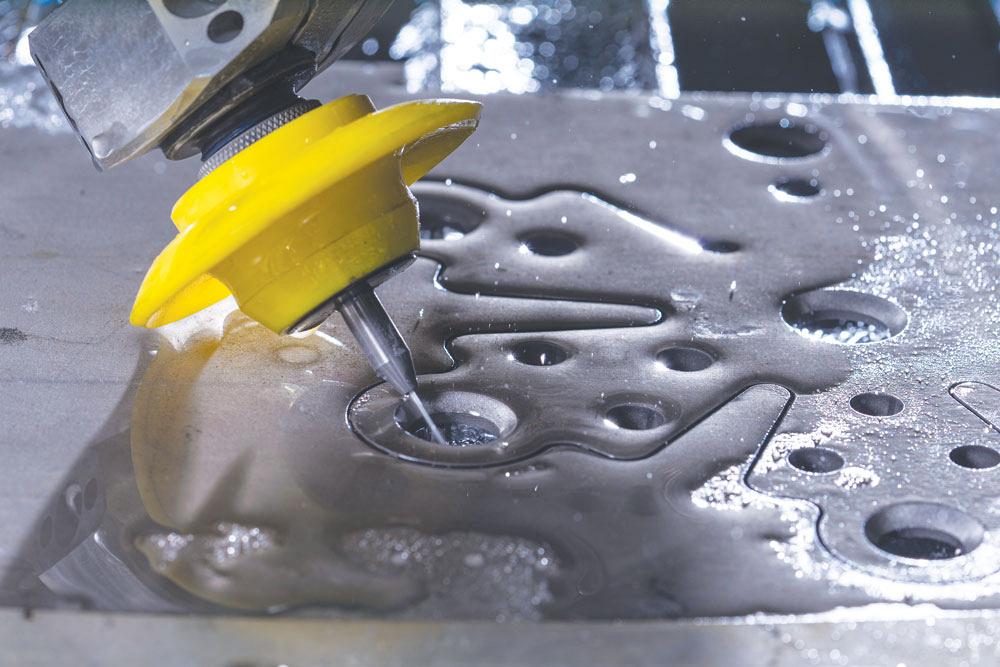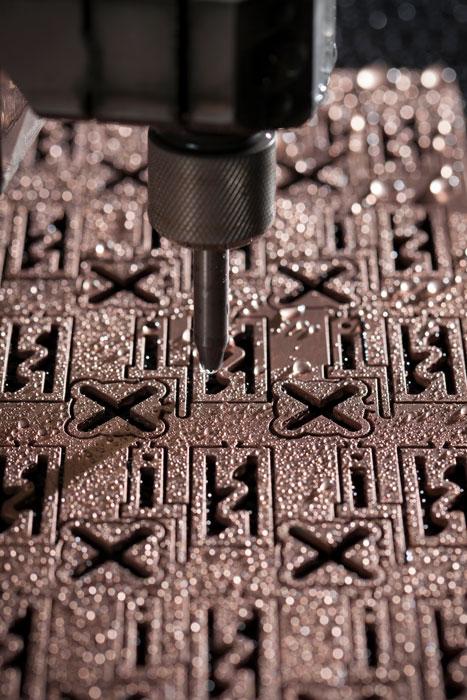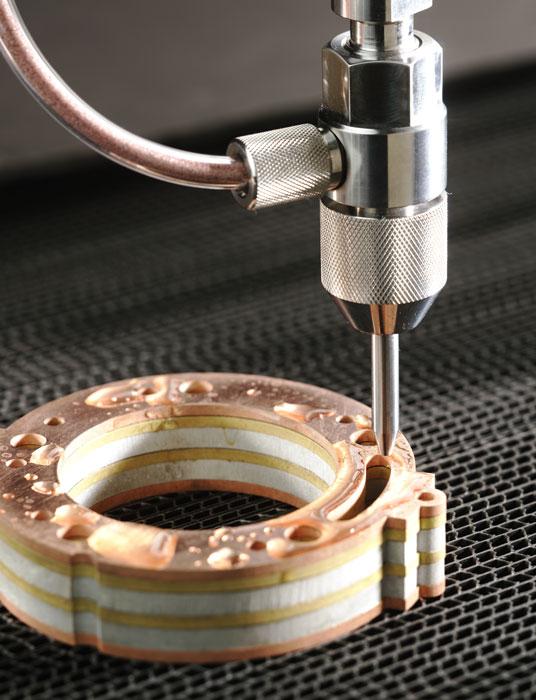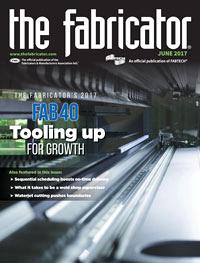Contributing editor
- FMA
- The Fabricator
- FABTECH
- Canadian Metalworking
Categories
- Additive Manufacturing
- Aluminum Welding
- Arc Welding
- Assembly and Joining
- Automation and Robotics
- Bending and Forming
- Consumables
- Cutting and Weld Prep
- Electric Vehicles
- En Español
- Finishing
- Hydroforming
- Laser Cutting
- Laser Welding
- Machining
- Manufacturing Software
- Materials Handling
- Metals/Materials
- Oxyfuel Cutting
- Plasma Cutting
- Power Tools
- Punching and Other Holemaking
- Roll Forming
- Safety
- Sawing
- Shearing
- Shop Management
- Testing and Measuring
- Tube and Pipe Fabrication
- Tube and Pipe Production
- Waterjet Cutting
Industry Directory
Webcasts
Podcasts
FAB 40
Advertise
Subscribe
Account Login
Search
What's trending in waterjet technology?
Multidimensional cutting, abrasive media recycling, intuitive software, smarter pumps, Internet connections, and PM are streaming
- By Kate Bachman
- June 1, 2017
- Article
- Waterjet Cutting

Fabricators need equipment that expands their versatility while facing challenges with diverse materials and thicknesses, frequently changing part requirements, and demands for productivity increases, industry experts say. Photo of waterjet cutting titanium courtesy of Flow International, Kent, Wash.
Fabricators must adapt to and overcome challenges related to frequently changing part requirements, said Stephen Bruner, vice president of marketing for OMAX® Corp., Kent, Wash. Whether they must make more complex cuts or use new and different materials, they must be versatile. Fabricators need to get the most capability out of every piece of equipment on their shop floors.
Fortunately, abrasive waterjet technology has historically been one of the most versatile cutting technologies in that it is nearly unlimited in terms of the material type, thickness, part size, and shape it can cut, Bruner said.
Brian Sherick, vice president of North American sales at Flow International, Kent, Wash., cited the need to simplify integration of waterjet technology into standard production flows. He also said that the break-fix model of operation must migrate to a preventive maintenance model to ensure continuity of operation.
Dave Dumas, director of waterjet OEM sales for Hypertherm, Hanover, N.H., weighed in. “Like everyone, waterjet fabricators are under constant pressure (no pun intended) to lower costs and increase productivity.”
Bruner, Sherick, and Dumas offer their perspectives on waterjet technology’s advances and predictions for its future.
1. How is waterjet technology evolving to help meet fabricators’ challenges?
Sherick, Flow: Waterjet technology is evolving to help fabricators on a few fronts.
We are committed to creating a more reliable and predictable system that requires less interaction with the equipment. With advanced system diagnostics and proper preventive maintenance practices, fabricators can realize greater predictability and uptime. The industry is migrating to using a preventive maintenance model. This is really a fundamental change. For years the industry has run in a break-fix model; the machine runs until it breaks and then it’s an emergency. We’re trying to offer fabricators the ability to not have to go through that.
In addition, expanding software capabilities are improving fabricators’ experiences with a simple-to-use CAD/CAM interface that is compatible with nearly all current file formats. Modern software architecture is designed to simplify the integration of waterjet technology into standard production.
We’re constantly improving and evolving the Flowmaster software cutting models that do taper compensation to empower the Dynamic Waterjet® to increase the accuracy and precision of the cuts. (see Figure 1).
Wrist articulation ±10 degrees (5-axis kinematics with articulated A/B wrist); high-precision clamping that allows fabricators to quickly attach or remove the cutting heads; and the touchdown height sensor that establishes proper standoff height are all helping fabricators become more versatile.

Figure 1
Efforts to improve accuracy and eliminate taper continue. Photo courtesy of Flow International.
Bruner, OMAX: Our A-Jet® articulated cutting head and the rotary axis allow fabricators to perform multidimensional cuts in up to six axes for bevels, 3-D shapes, and pipes on one machine.
For tight part tolerances, taper compensation technology such as the Tilt-A-Jet® eliminates taper and generates high-precision parts with squared edges without slowing the cutting speed.
Fabrication shops are also implementing waterjet technology as a cost-effective complementary machining method to cut parts to near-net shapes. This, in turn, helps maximize raw material utilization and accelerate overall part production.
Dumas, Hypertherm: We are focusing on uptime. We believe a lot of opportunity exists to lower costs and increase productivity by reducing operating costs and addressing maintenance via scheduling rather than operating in a break-fix mode. We are working on shortening the time it takes to service a system while also extending maintenance intervals so that fabricators can spend more time cutting. An unexpected disruption during manufacturing can result in the need to scrap expensive material and productivity loss.
Also, since the cost of abrasives typically accounts for more than half of the operating expense for a waterjet system, products that help fabricators manage their abrasive media are available today and are becoming more commonly used with every passing year.
2. What new developments are enhancing waterjet technology?
Dumas, Hypertherm: To meet our goal to extend uptime, we introduced a new diamond orifice with a cutting lifespan that’s greater than 1,000 hours (see Figure 2).
Another uptime-extending feature is stroke monitoring that lets fabricators know if their pump is not operating as optimally as it should be (see Figure 3). Improved user interfaces (graphics) have been incorporated into pumps to help operators monitor performance. In addition, Hypertherm has launched a mobile assistance app that can provide shops with important service information about their pumps.
We are also working on products and equipment, such as the EcoSift™ abrasive recycling system that lets fabricators capture, recycle, and reuse spent abrasive to reduce abrasive media and handling costs.
In addition, we have several channel partners that offer robotic waterjet cutting.
Sherick, Flow: Our latest waterjet systems can accelerate at nearly twice the rate and cut parts with better accuracy than older legacy machines. For example, the Mach 500 has a rapid traverse maximum speed of 700 inches per minute (IPM) with a linear straightness accuracy of ± 0.0015 in. per 3 feet.

Figure 2
Hypertherm introduced a new diamond orifice with a cutting lifespan that’s greater than 1,000 hours intended to help fabricators extend uptime. Photo courtesy of Hypertherm, Hanover, N.H.
We focus on ensuring predicable uptime and have launched new preventive maintenance and exchange programs to accomplish that.
Some of our advancements are still under development. Our software is evolving to take advantage of the latest control capabilities and work as a united fabric to support equipment productivity and reliability.
We offer new system configurations with 3-, 4-, and 5-axis cutting capabilities. In addition, we partner with Aquarese and Tech-Con Automation for highly specialized applications.
Bruner, OMAX: We strive to make our machines easier to use and maintain with every new innovation. Some of the more recent ones are a new version of our control software suite, an automated solids removal system, and an extended-life nozzle.
To help fabricators struggling to find seasoned, highly qualified operators, we’ve developed easy-to-learn machines. To date, we’ve released more than 23 updates of our intuitive Intelli-MAX® Software Suite. After only one day of training, operators can successfully get our waterjet up and running and cutting parts.
Since machine downtime halts production, our large-format solids removal system (SRS) not only automates waterjet garnet removal, it eliminates the need to shut down the machine to do so. The SRS automatically removes garnet from the water tank and pumps it to a location up to 100 feet away, all while the machine continues to work.
The more accurate a jet stream, the less wear the mixing tube assembly and the nozzle experience. For extended waterjet nozzle life, our MAXJET®5i diamond integrated—into the jewel orifice—nozzle better aligns the waterjet stream and provides a working life upwards of 500 hours.
3. What innovations in waterjet technology can people expect to see in the future?
Bruner, OMAX: While the basic principles of waterjet cutting will tend to remain constaant, in the future we see the technology increasingly applied in new and different ways. More fabricating shops that in the past may have never even considered waterjet cutting will discover new opportunities for it, especially to process complex workpieces and challenging materials.
In the coming year and beyond, abrasive waterjet technology, much like chipmaking machine tools, will also continue to move toward digital connectivity and the Industrial Internet of Things (IIOT)/Industry 4.0. With Internet-connected machines via the MTConnect protocol, tomorrow’s OMAX abrasive waterjet systems will sport more forward-thinking features and functionality specifically for process monitoring, preventive maintenance, and lights-out production capability.
Dumas, Hypertherm: We believe a major focus will be on making maintenance more predictable and reducing downtime in general.

Figure 3
Hypertherm has launched a mobile assistance app that can provide shops with important service information about their pumps. Photo courtesy of Hypertherm.
Abrasive media management and recycling may also be key, given that more than half of the operating cost of abrasive waterjet cutting is tied to garnet abrasive. Abrasive recycling equipment will eventually help fabricators significantly reduce the total cost of their abrasive media.
I believe waterjet users can expect pumps and systems to become smarter and more connected in the future. This will naturally lead to providing more useful information to fabricators and allow them to improve their maintenance planning.
Sherick, Flow: In the future waterjet machines will be a “good citizen” in the fab shop. They will be quiet, clean, and productive.
Waterjet technology will be considered a critical process for fabricators to compete in an ever-changing business environment. We expect to see waterjet cutting evolve into an even more reliable, predictable process through better technology and factory maintenance programs.
We will continue to focus our future initiatives on maximizing machine uptime and lowering the cost of ownership.
Flow Intl. Corp., 253-246-3416, www.flowcorp.com
Hypertherm, 800-737-2978, www.hypertherm.com
OMAX, 800-838-0343, www.omax.com
About the Author

Kate Bachman
815-381-1302
Kate Bachman is a contributing editor for The FABRICATOR editor. Bachman has more than 20 years of experience as a writer and editor in the manufacturing and other industries.
subscribe now

The Fabricator is North America's leading magazine for the metal forming and fabricating industry. The magazine delivers the news, technical articles, and case histories that enable fabricators to do their jobs more efficiently. The Fabricator has served the industry since 1970.
start your free subscription- Stay connected from anywhere

Easily access valuable industry resources now with full access to the digital edition of The Fabricator.

Easily access valuable industry resources now with full access to the digital edition of The Welder.

Easily access valuable industry resources now with full access to the digital edition of The Tube and Pipe Journal.
- Podcasting
- Podcast:
- The Fabricator Podcast
- Published:
- 04/16/2024
- Running Time:
- 63:29
In this episode of The Fabricator Podcast, Caleb Chamberlain, co-founder and CEO of OSH Cut, discusses his company’s...
- Trending Articles
How to set a press brake backgauge manually

Capturing, recording equipment inspection data for FMEA

Tips for creating sheet metal tubes with perforations

Are two heads better than one in fiber laser cutting?

Hypertherm Associates implements Rapyuta Robotics AMRs in warehouse

- Industry Events
16th Annual Safety Conference
- April 30 - May 1, 2024
- Elgin,
Pipe and Tube Conference
- May 21 - 22, 2024
- Omaha, NE
World-Class Roll Forming Workshop
- June 5 - 6, 2024
- Louisville, KY
Advanced Laser Application Workshop
- June 25 - 27, 2024
- Novi, MI


























